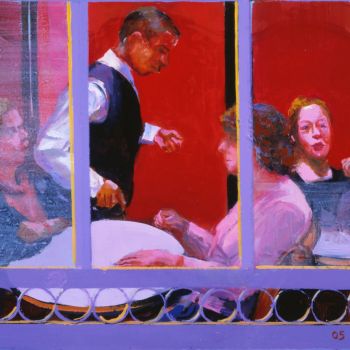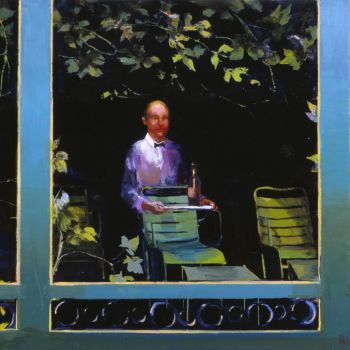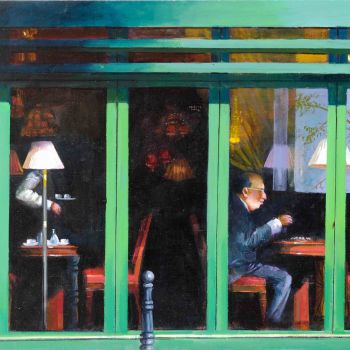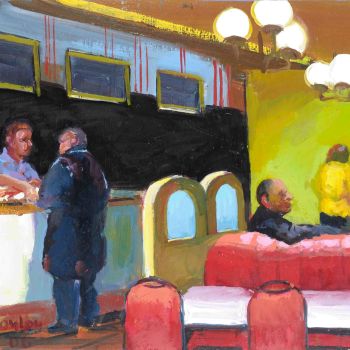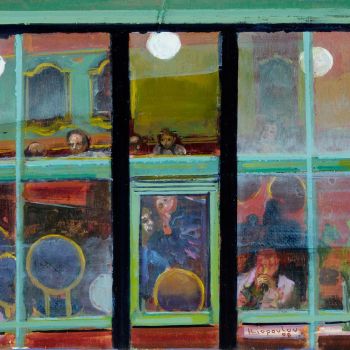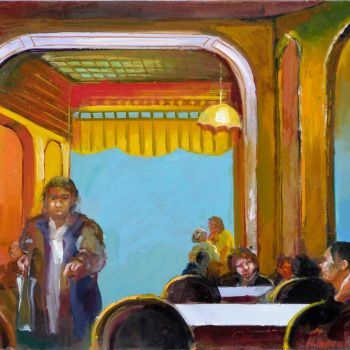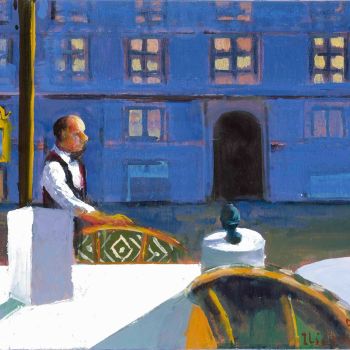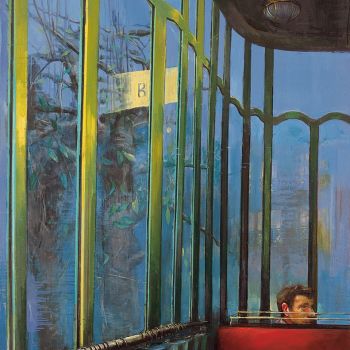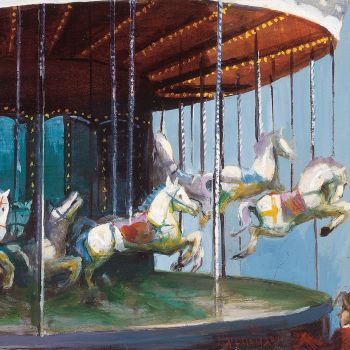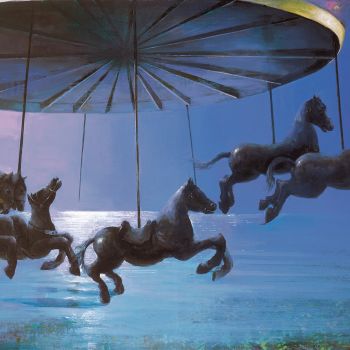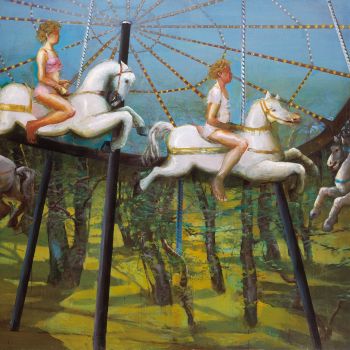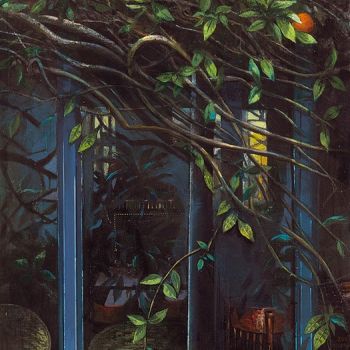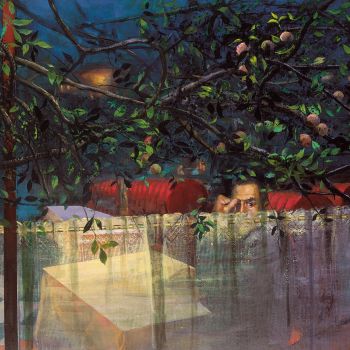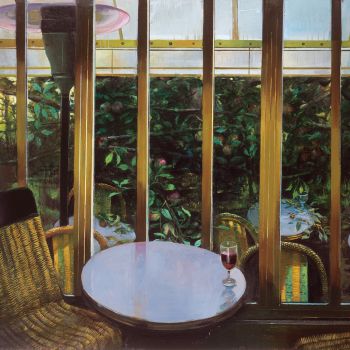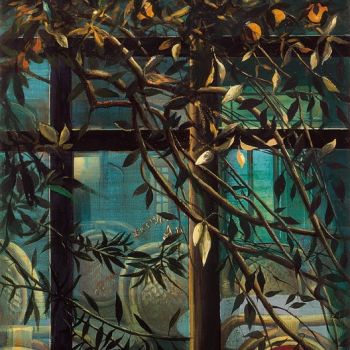As far back as 1992 Irini Iliopoulou made her presence felt at the Salon de Mars with her bovines- massive volumes, stolidly graceful in their largeness, serenely imposing in their dignified watchful silence. Creatures that sit and wait amidst burnt earthen tones, the tawny and chocolate hues of marsh and wetlands, the dank dregs of bog. And then she left these beasts behind in Paris to uncover the terrain of southern France.
Landscape comes alive in this period of painting: gnarled vines, kinky leaves, tangled stems, entwisting arthritically, branches akimbo, jutting out like elbows, trunks enlocked like crossed legs or seemingly swaying to the rhythm of a swing or hammock. Soil turned visceral, gutted, innards spilt and gleaned, upturning animistic roots and rocks. Bile yellow of lonely disenchanted fields... The disturbing element in her landscapes next metamorphosed into the human figure- castaway, a casualty, some body half-buried in a tomato patch or asleep under the cover of a pear tree, or a spectre levitating at a reservoir. The figures in these paintings seem to be caught unawares, if not unconscious- bodies in repose or asleep in unusual places as if they’d trespassed, were hiding, or lost. As viewers we experience a voyeuristic ambivalence before these scenarios like catching someone drawing graffiti on the courtyard wall. There’s a discomfort when confronting the indifference of the somnambulist, the revenant’s hypnotic stare, a spirit watching inside a storefront window displaying costume dummies. At times the figures seem almost captive, detained behind a windowpane, encased like wildlife in captivity. The customer in the garden café stares back defiantly feral. But these exchanges form the exception because in most of the café and bar paintings the viewer's glance is eluded- met by an averted gaze, eyes held abashedly half-mast, glance askew, regard downcast. Irini’s depictions are neither bucolic nor romantico-dramatic as in the grisly aftermath of a disaster, but instead anticipate something menacing or intimate its narrow escape. Here nature suddenly encroaches upon 'civilization'. Nature is pictured as unruly even if the weather's mild. Irini’s ingenuity lies in this wonderland effect: nature unexpectedly outgrowing itself. She casts nature in the leading role while her figures are mere walk-ons, just as the apparitions of her earlier works were not intended to be especially realistic but more phantasmagoric. Now cafés are besieged by lemon and orange trees. Irini’s works deal in unlikely occurrences, unexpected happenings, not verisimilitude.
In her cafés, objects take on uncustomary color, a life of their own once infused with paint. The pastry and costume shops, boutique display cases and open-air markets, among other Athenian flora favored by the artist, are all rendered in the same vibrant, sensual manner (aside from the occasional eeriness invoked by masks and mannequins). Irini’s brush tends to be rebellious as she boldly and whimsically diffuses color. She exploits the sumptuousness of color in her descriptions of both the prosaic café interiors and the uncanny outdoors. Some cafés could be taken for terrariums- the condensation on the windows, the blurry muggy hothouse green. In the present series, red is predominant in all its shades and hues- flushed cheeks, startled faces gone crimson recalling the ruby-red theatres, seats ensconced in scarlet. Table tops and booths stained blood orange, berry-red curtains and screens, vermilion cushions that contrast with burnished dividers and window frames, mirrored in the dull sheen of marbled formica and zinc.
Irini is drawn to the anonymity of public watering holes. She's less intrigued by their folklore than the life of the places themselves. Where tourists seat themselves for people watching, Irini goes inside to observe the local fauna. She treats her cafés like stage sets and focuses on their décor instead of the characters who play only a minor role. They provide the setting for a meditation on vacancy and loneliness: how solitude occupies space, how loneliness haunts, how haunts can be lonely places... Irini’s cafés tend to be half-empty. Paradoxically, there is no sense of the forlorn. We don't view their occupants as lost souls although the cafés do depict “etats d’ame”, frames of mind or “states of the soul” (rainy, blustery, a “blue” mood or a redone) and also host customers who may appear to be lost in thought. Irini’s verdant cafés however are of her own imagining. The painter winks at the idyll genre yet these works are more akin to the films of Alain Resnais than places actually frequented. “Country cafés” that she’s dreamed up as sanctuaries, shelters from the storms of life. The comfort of watching a downpour from inside a bar. The consolation of the threat contained but still visible from your window seat. Non-existent places or places so rare they risk extinction. “Reserves” where solitude is respected, framed by a décor and where wilderness infringes with only the glass window to protect us, separate us from “the wild”. Foggy windows reflect the lamp glowing outside entwined by overgrown foliage.
Previously, Irini had put the stage on canvas in the series of Vieux Colombier Theater interiors while here she puts nature in the forefront. A tree seems to be reaching down for a glass on an empty table- recently vacated or awaiting a customer's return- an eloquent allusion to the presence/absence opposition devoid of human figuration. On the same note, cafés that are almost empty evoke the sentiment of solitude more poignantly than a full house. A solitary individual echoes the idleness of an empty bar just as a deserted wine glass suggests departure. A customer can observe the spectacle of “urban wildlife” from his café table. Urban oases- places of repose, contemplation and waiting. The backdrop for encounters, conversations, farewells… Would you prefer to be alone, obscure, invisible? Irini delineates disclosure scenographically- umbrellas, awnings, drapes, intricately crocheted or lacy curtains from behind which figures peer out, are protected or concealed. Folding screens partition interior space, compartmentalize, section off public and private while the figures remain anonymous due to the painter’s deliberate disregard for physiognomic detail. Faces are blushed, dabbed, blotted. The café scenes are not cinemagraphic yet convey motion. We can overhear snatches of conversation; feel people shifting in their seats. In the painting entitled “Paroles sur rouge” the stiffness of the quarrelling lovers emboldens the booth-backdrop. The woman’s visored regard and the man’s profile denote disappointment- happiness poisoned, like a spiked drink. Their wine appears diluted in contrast to the fiery decor set off by a pitch-black background. Irini prefers the café/bar setting to dining rooms (with the exception of the ferris wheel/balloon set). Cafés are conducive to intrigues, meetings.. .for the first time or the last, but certainly not for the dinner table. They have their own idiom (a quick one, one for the road, bottoms up) and etiquette where, for example, only artists are allowed to loiter, absorbed in private reflection- the mystique of the lone customer. There's a decorum too that grants even the local drunk his dignity- his bar stool, his barman-confessor, his tab, his drinking pals, loyal patrons like vintage fixtures, local color.
France being Irini’s spiritual home, it's only fitting that we find allusions to the Parisian paradigm of café culture- from the waiters in livery to architectural style and interior decoration. The seaside cafés, however, are of a totally different breed. Here we're struck by the blinding glare of the Mediterranean sun as opposed to the silver shade of rain, the steely shadow of storm clouds. The Hitchcock-like waiter with downcast eyes, discretely reappears from painting to painting, from city to seaside. A parasol puffs up to shield from the sun's unrelenting scrutiny. We sense the oppressiveness of the heat as it literally weights down the tarp providing cover for the ferry café. The waiter himself appears almost burdened by the heat, as if trudging with a heavy load on the boardwalk whereas his tray isn't even visible, likely hangs at his side.
Achieving the estival cycle Irini introduces a series of outdoor cinema paintings of which the most playful is undoubtedly “Watermelon”. The screen is smeared in an appetizing pink, the lushly striped canvas chairs are taut with the weight of bodies slumping into abandon, backsides like rinds of ripe melons. Whitewashed chairs refract the blank screen just before dusk. In another painting, sun-bleached seats glow mothlike in the penumbra of a film. These scenes are more populated than any of her cafés. They don't feature solitude but rather a small community of movie-goers congregating for entertainment and escape, their backs turned to us. The cinemas are like so many niches between apartment buildings. The spectators are sunk in their seats, prepared for transport. Nocturnes celebrating the coolness of the night when the sun finally relents, where a dab of moon glistens, with their shrubbery and greenery promising some relief from the looming buildings, still hot to the touch after a day's baking. The scant palms recall the proverbial oasis, summer cinema being the city dweller’s little paradise.
The cinema compositions resemble the suite of cafés in their enchantment. The audience is engrossed, entranced as if awaiting some revelation (the film). The café-goers are absorbed, heedless of onlookers, fully engaged in their private activities, enveloped by voluptuous colors. The movie audience is hushed by nightfall or steeped in inky darkness. Frames of mind and moods are made palpable by pigmentation, lighting contrasts, body contours. Irini’s palette makes even solitude palatable when presented in a lamplight's golden hue. She actually stirs in the viewer a longing for the intimacy of a quiet café, a nostalgia for refuge from inclemency. We want to visit those fantastic, dreamlike cafés that blend beauty and bizarrerie, where trees beat on the windows threatening to invade our privacy. Beyond the sumptuous colors, Irini’s eye for the gestural, and notably “body language”, is enhanced by her inherent theatrical sense. Within the context of each frame, or “still”, the painter arranges her material choreographically. Character definition is given like so many stage directions- a figure's gait, bearing, posture, the way clothes fall on a body, how and where they situate themselves in a setting (at the chair’s edge, slouching, erect, at the margin, on the border of the frame...). Corporal expression creates atmospheric effect. Irini’s cafés are inhabited by patrons, the empty ones by the spirit(s) of the place, full of their own ambiance. With this body of works Irini Iliopoulou entertains the notion of occupancy. Her cafés beckon to our solitary longings and more strangely, our desire for disorientation. There’s a vacancy in her scenery that invites imagination, a place the painter has consciously reserved for the viewer.
September 2006
Andrea Schroth


